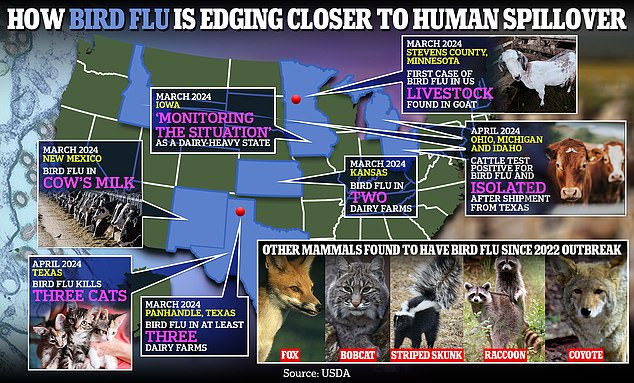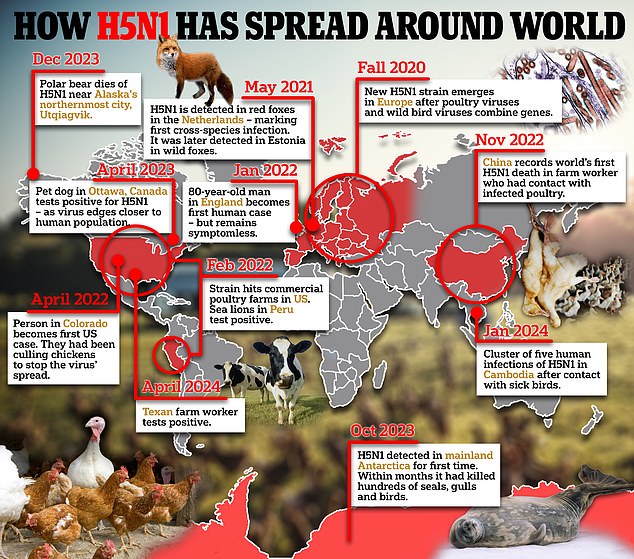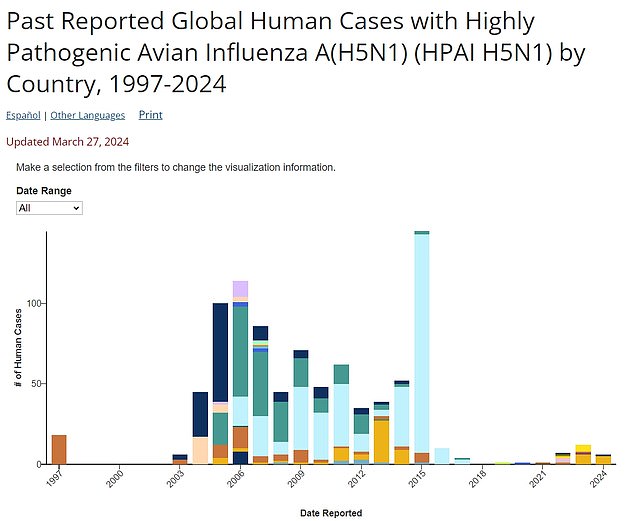The CDC is taking the bird flu outbreak in the United States “very seriously” amid growing fears that the virus could jump to humans and cause an epidemic.
A farm worker in Texas this week became the second American infected with the H5N1 strain after contracting it from an infected cow; It is also the first time that avian flu has been found in livestock.
Mandy Cohen, the agency’s director, told NPR that officials were “monitoring the situation very closely” as farms in six states battle outbreaks on dairy farms.
The ease with which this virus jumps between species increases the risk of it evolving to better infect people, prompting one expert to tell DailyMail.com that it could pose a greater risk than Covid.
Cohen said, “That just means more opportunities for this virus to mutate and change.” And that’s what we want to make sure we continue to stay ahead of.”

The above shows how bird flu is approaching human contagion in the US.




Dr. Mandy Cohen, director of the CDC, says they are closely monitoring the situation. WHO Director General Dr. Tedros Ghebreyesus says they are also in contact with the CDC
It turns out that global agencies, including the WHO and an EU expert panel, are also expressing concern about the risk of the virus spreading to humans.
The head of the World Health Organization, Dr. Tedros Ghebreyesus, confirmed yesterday that the organization was in “close contact” with the CDC.
“Any case of H5N1 is worrying,” he said, “because it is very dangerous to humans, although it has never been shown to be easily transmissible between people.”
Other organizations have also raised the alarm, including the Paris-based World Organization for Animal Health, which said infections in more and more animals raised the risk of the virus spreading to humans.
The White House has said it is “monitoring” the situation and that the president is being kept informed.
Dr Cohen said: “What we have learned through Covid in our experience is that viruses change and we need to anticipate.”
“That’s why we at the CDC and the entire US government are taking this very seriously and monitoring the situation very closely.”


However, he added: “We have never seen a case of human-to-human transmission of avian flu here in the United States.
‘And the version of bird flu that we are seeing in livestock, and in this case humans, is the same strain (H5N1) that we have previously seen in birds.
“We’ve never seen that spread from person to person.”
Of the Texas patient, he added: ‘The person had very mild symptoms. They are recovering well.
“But we want to make sure, again, that we are testing people who may have been in contact.”
He also said the agency was working closely with partners and state and local veterinarians to detect more infections in livestock.
“This is a new reservoir or group of animals that we’re seeing this virus in,” he said, “and that just means more opportunities for this virus to mutate and change.”
The CDC yesterday published an analysis of the virus that infected the patient in Texas, revealing that it had acquired a mutation related to making it more transmissible in mammals.
But the agency assessed that the risk of the virus was still “low” and added that this mutation had been recorded previously.
There is no evidence to suggest that current strains of bird flu can pass from one human to another.
But amid concerns, federal officials are preparing vaccine supplies in case there are more human cases.
They already have two candidates available, officials told the Washington Postwhich could be implemented in a matter of weeks or months if necessary.
Officials also insisted they were well prepared to detect whether a person has H5N1 through the agency’s regular surveillance for seasonal flu at more than 100 public health laboratories in states across the United States.
Experts say it would be easier to make a vaccine against H5N1 than the coronavirus because several shots are already available to combat bird flu.
Millions of doses are already in the strategic national stockpile, which could be deployed if necessary.
In February, the Agriculture Secretary also said the country was “approximately 18 months” away from developing a vaccine against the current strain of bird flu.


The above shows H5N1 cases in people by country since 1997. The virus underwent a major change in 2020 when a wild and domestic version was combined.
The Texas patient suffered only one symptom – eye inflammation – and is recovering well after being treated with the antiviral oseltamivir (Tamiflu).
They have been isolated and at the moment there are no signs that the infection has spread to other humans or to the patient’s respiratory tract.
It was unclear how they became infected, but it is possible that they touched their eyes after their hands became contaminated with the virus.
Avian flu can infect the human eye because it carries the same receptors as the lungs of birds.
But human lungs, where the disease could cause severe illness and pneumonia, carry very different receptors, and there are no signs that the virus has spread to this area in the patient.
Experts are increasingly alarmed by the variety of animals that bird flu is infecting: from seals to raccoons and skunks.
It is also infecting more animals that have close contact with humans, including cats, dogs and livestock, increasing the risk that it could be transmitted to humans.
Experts fear that each new infection increases the risk of the virus acquiring mutations that allow it to spread better between people.
It comes after experts yesterday warned that bird flu could be much worse than Covid if it started to spread between people.
At a news conference yesterday, Dr. Suresh Kuchipudi, a bird flu researcher in Pittsburgh, said: “This virus (has been) at the top of the pandemic list for many, many years and probably decades.”
“And now we are getting dangerously close to this virus causing a pandemic.”


Bird flu has jumped to other animals, including seals, and 17,000 pups died in a colony in Argentina earlier this year amid fears the virus managed to spread between animals.
The WHO estimates the fatality rate for H5N1 at 52 percent, based on the 462 deaths recorded since 2003 among the 887 people diagnosed with the virus.
By comparison, Covid currently kills about 0.1 percent of the people it infects, although at the beginning of the pandemic that figure was around 20 percent.
Since 2020, when the new strain of bird flu emerged and spread around the world, seven in 26 people infected with H5N1 have died, or nearly 30 percent.
Concerns about bird flu arose a fortnight ago when cows began testing positive for the virus, which experts said was the “last” species they expected to contract the virus.
So far, 12 dairy herds in six states have tested positive and most are linked to herds in Texas, where five herds have been shown to have the disease.
It is currently unclear how the cattle became infected and whether the virus has spread among cattle, although experts say this is possible.
The last human infection with H5N1 in the US was recorded in 2022, when an inmate working at a poultry farm in Colorado tested positive for the disease.
Experts say there is very little risk of contracting bird flu from milk because virtually the entire U.S. supply is pausterurized before hitting shelves, which inactivates the virus.
Milk from cattle known to be infected with bird flu is also removed from the supply, further reducing the risk.
But experts fear that if more cattle test positive, it could reduce the amount of milk the United States produces, driving up prices.
There are also concerns about egg prices after the largest US egg producer, Cal-Maine Foods in Texas, revealed that bird flu had been detected in its flock and that 2 million chickens now need to be culled.
Bird flu was behind the rise in egg prices in 2022, with a dozen Grade A brown eggs rising from $1.72 to a high of $4.82 in January 2023.
There are fears the same could happen as more birds are culled amid concerns over the bird flu outbreak.

